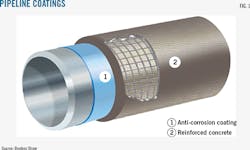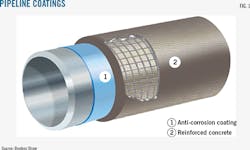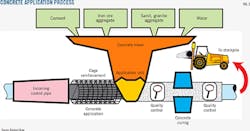DNV, others researching concrete-coating improvements for subsea pipelines
Christopher E. Smith
Managing Editor, Technology
With submarine pipelines increasing in diameter and extending into deeper waters and more difficult environments, design requirements for concrete weight coating often don't meet current needs. The result is inconsistent safety margins and potentially expensive overdesign and stringent installation requirements. DNV GL AS has started a joint industry project (JIP) to address these issues and improve the understanding of pipeline concrete behavior
Current participants include Petroleo Brasileiro SA (Petrobras), Saipem SpA, Bredero Shaw, Ballast Pipelines SVAP Ltd., and Wasco Coatings. The JIP intends to develop a design guideline that complements current pipeline codes and standards and is still open to other participants.
Concrete weight coating is widely used to protect submarine pipelines and ensure stability on the seabed. The current design approach for pipeline concrete coating is primarily based on simple and general design requirements. Fig. 1 shows a typical concrete coating, with Fig. 2 outlining the application process.
The current coating method has proven reasonably reliable for most traditional pipelines but does not capture all potential failure modes. Recently, several cases of concrete coating damage have occurred during installation and operation, with varying degrees of severity and potential risk.
Preliminary studies conducted by DNV GL suggest that in-depth knowledge about the contribution of and interaction among several factors is needed for industry to understand pipeline concrete coating behavior (e.g., the shear transfer capacity, coating thickness, strength, fabrication method, type, location, spacing, percentage steel reinforcement, and loads). DNV says it is important to validate these factors against recent test results combined with knowledge gained from industry experience before incorporating them into pipeline codes and standards
The JIP will lead to a rational design approach based on a quantitative understanding of concrete-coating behavior in response to external loads and the interaction between the important mechanisms and factors that influence this behavior, according to DNV. The JIP's first phase will develop a design approach for pipeline concrete coating and is due for completion by December. The second phase is for an experimental validation of the design approach and development of a design guideline for pipeline concrete coating. DNV expects the JIP to finish by yearend 2016.
Other research
The Egyptian Petroleum Research Institute has also been investigating ways to prevent concrete-coating overdesign while at the same time maintaining safety, emphasizing the use of locally sourced hematite high-density iron ore as a means of reducing cost.1 Laboratory and field tests of a concrete mix using the local ore, cement, and water combined according to international requirements produced a coating with 190-195 lb/cu ft minimum dry density and a compressive strength after 28-days hydration of 40-45 MPa, in compliance with current international standards.
The field-tested mix consisted of 1,800 kg hematite (69%), 670 kg cement (23%), and 197 l. water (8%). Moisture content of the aggregate produced from local hematite measured 0.3%, well below the 3% maximum. The Egyptian study also verified earlier conclusions that aggregate particles 9.5-0.15 mm produce maximum compaction, compressive strength, dry density, and low water absorption.1
By comparison, Bredero Shaw's HeviCote concrete coating has a density of 112-215 lb/cu ft, a 28-day compressive strength of 40-50 MPa, and can be applied in thicknesses of 1-9 in. on 6-56 in. OD pipes ranging 28-60 ft long. Wasco's Vibrodens coating density measures 150-231.25 lb/cu ft, with a compressive strength of 40-55 MPa.
Varying the amount of iron ore in the coating changes its density, while compressive strength changes with a coating's cement-water content ratio. Coating cannot maintain required cohesiveness with concrete content less than 300 kg/cu m.
A University of Western Australia engineer, meanwhile, seeks to cut costs by taking advantage of subsea pipelines' tendency to self-bury. Simon Leckie estimates the industry spends $1.6 million (AUS)/km to prevent subsea pipelines from moving during cyclones and proposes that an improved understanding of this process could cut outlays currently made for weight coating.2
Leckie studied 7 years of data from regular inspections of Woodside Petroleum's North West Shelf project, determining tides started causing pipes to settle into the seabed almost immediately. Pipes sink into the shoulders of solid seabed on either side of spans created by sediment transport, resulting in an undulating profile of embedment and spanning (Fig. 3).3
Leckie and his colleagues found that most of the lowering occurs within 2 years of pipelay and is caused primarily by ambient currents as opposed to large storms. Embedment is largely uniform, suggesting the pipeline lowered mainly through sinking into the seabed at span shoulders rather than sagging into scour holes and can reach as much as 80% OD.4
To the degree this phenomenon and the associated resistance to lateral loading can be accurately estimated in advance, Leckie reasoned, it can be used to reduce coating costs.2
Projects
The scale of today's offshore projects makes research on pipeline stability a practical concern. Some current large concrete-coating projects follow.
BP Exploration (Shah Deniz) Ltd. in November awarded ShawCor division Bredero Shaw a $200-million contract for pipeline coating on the Shah Deniz II natural gas development in the Caspian Sea for both anti-corrosion and concrete weight coatings. Bredero Shaw will coat the pipe, under its second contract for the project, at the Caspian Pipe Coatings plant Baku, Azerbaijan, targeting October 2015 completion. The contract brought Bredero Shaw's total work on Shah Deniz II and South Caucasus Pipeline to $500 million.
Bredero Shaw also provided coating services for Statoil Norway's Edvard Grieg oil pipeline project and Utsira High gas pipeline project, executing the contract for 98 km of 16-in. OD pipe and 46 km of 29-in. OD pipe at its Leith, Scotland, plant.
Mitsui-Bredero provided concrete coating for the Inpex-operated Ichthys LNG project's 889-km gas export pipeline from the Browse basin off Western Australia to Darwin. Ichthys deepwater pipelay began Feb. 6, Saipem's Castorone laying 718 km of 42-in. offshore line following completion in November of the 164-km shallow section.
Wasco Energy last year built a plant in Mo i Rana, Norway, to apply concrete coating to the 40,000 36-in. OD individual pipe lengths that will comprise Statoil's offshore 480-km Polarled natural gas pipeline from the Aasta Hansteen development north of the Arctic Circle on the Norwegian continental shelf to a Shell-operated gas plant at Nyhamna.
References
1. Abdou, M.I., and Abuseda, H., "New heavy aggregate for offshore petroleum pipeline concrete coating, Central West Sinai, Egypt," Egyptian Journal of Petroleum, Vol. 23, No. 4, December 2014, pp. 389-395.
2. http://www.maritime-executive.com/article/offshore-pipe-burial-could-be-cheaper, Jan. 28, 2015.
3. Leckie, S.H.F., Cheng, L., Draper, S., and White, D.J., "Pipeline On-Bottom Stability and Thermal Expansion Management: The Interaction of Sediment Transport, Geotechnics, and Structural Behavior," Australian Research Council Centre of Excellence, Geotechnical Science & Engineering (CGSE) Annual Workshop, Bunker Bay, Australia, Dec. 10-11, 2013
4. Leckie, S.H.F., Draper, S., White, D.J., Cheng, L., and Fogliani, A., "Lifelong embedment and spanning on a mobile seabed," Coastal Engineering, Vol. 95, January 2015, pp. 130-146.



